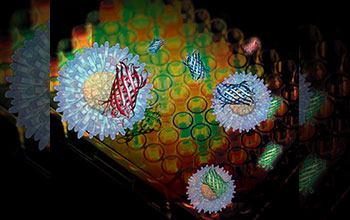Multimedia Gallery
New approach to screening drugs using gold nanoparticles
Chemists have devised a multi-channel, signature-based approach to screening drugs using gold nanoparticles with red, green and blue outputs provided by fluorescent proteins.
Traditional screening methods currently used are time-consuming and require special equipment. The new approach can accurately profile various anti-cancer drugs and their mechanisms in minutes.
This invention could potentially have a substantial impact on the drug discovery pipeline says Le Ngoc, a doctoral graduate student who worked on the research with lead researcher and chemist Vincent Rotello. "The sensor is not only able to profile mechanisms for individual drugs but also determine the mechanisms of drug mixtures; that is, drug 'cocktails' that are an emerging tool with many therapies," says Ngoc.
The research was supported in part by the Center for Hierarchical Manufacturing at UMass Amherst, a National Science Foundation Nanoscale Science and Engineering Center, under grant CMMI 10-25020.
To learn more about this research, see the UMass Amherst news release Promising new method found for rapidly screening cancer drugs. (Date of Image: 2013-2014)
Credit: Vincent Rotello, Department of Chemistry, University of Massachusetts-Amherst
See other images like this on your iPhone or iPad download NSF Science Zone on the Apple App Store.
Images and other media in the National Science Foundation Multimedia Gallery are available for use in print and electronic material by NSF employees, members of the media, university staff, teachers and the general public. All media in the gallery are intended for personal, educational and nonprofit/non-commercial use only.
Images credited to the National Science Foundation, a federal agency, are in the public domain. The images were created by employees of the United States Government as part of their official duties or prepared by contractors as "works for hire" for NSF. You may freely use NSF-credited images and, at your discretion, credit NSF with a "Courtesy: National Science Foundation" notation.
Additional information about general usage can be found in Conditions.
Also Available:
Download the high-resolution JPG version of the image. (5.8 MB)
Use your mouse to right-click (Mac users may need to Ctrl-click) the link above and choose the option that will save the file or target to your computer.



